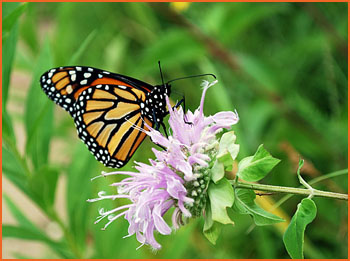Stewardship and Conservation 
While the monarch butterfly is not an endangered species, its migration is considered an “endangered natural phenomenon.” The following resources provide helpful information in promoting monarch stewardship and conservation.
The Monarch Butterfly Is in Trouble
From the U.S. Fish and Wildlife Service
https://www.fws.gov/savethemonarch/
Numbers of monarchs have decreased significantly over the last 20 years, but together we can save the monarch. In the United States, there is a massive effort to provide habitat for monarch butterflies, imperiled bumble bees and other pollinators. There is no one group or agency responsible for providing habitat needed for monarch conservation. All organizations, agencies and individuals must work together to improve, restore and create grassland habitats to save monarchs. No matter who you are or where you live, you can get involved today. Start by planting milkweed and nectar plants that are native to your area. Garden organically to minimize your impacts on monarchs, their food plants, and other pollinators. Become a citizen scientist and monitor monarchs in your area. Educate others about pollinators, conservation and how they can help.
Monarch Butterfly Fund: Conserving the Migration
http://www.monarchconservation.org/
The Monarch Butterfly Fund works to foster the conservation of North American Monarch butterflies and their migration through habitat restoration, research, monitoring, education and support for sustainable community development in and near monarch habitats in Mexico.
Monarch Watch's Monarch Waystation Program
http://www.monarchwatch.org/waystations/
To offset the loss of milkweed and nectar sources, Monarch Watch encourages people to create, conserve, and protect milkweed/monarch habitats. "Monarch Waystations” can be established in home gardens, at schools, businesses, parks, zoos, nature centers, along roadsides, and on other unused plots of land. Without a major effort to restore milkweeds to as many locations as possible, the monarch population is certain to decline to extremely low levels.
North American Monarch Conservation Plan
http://www.cec.org/islandora/en/item/2350-north-american-monarch-conservation-plan-en.pdf
Monarchs depend upon a wide range of habitats in Canada, the United States and Mexico, thus conservation of their migratory phenomenon requires trilateral cooperation. The North American Monarch Conservation Plan (NAMCP) is intended to provide a long-term cooperative agenda for conservation of the monarch butterfly.
Things You Can Do
From the USDA Forest Service
https://www.fs.fed.us/wildflowers/pollinators/Monarch_Butterfly/do/index.shtml
Every backyard can become an oasis for monarchs and other pollinators, even in cities. Schools, youth and community groups, businesses, and state and local governments can engage in planting native milkweed and protecting monarch habitat along roadsides, rights of way, and other public and private lands.


























